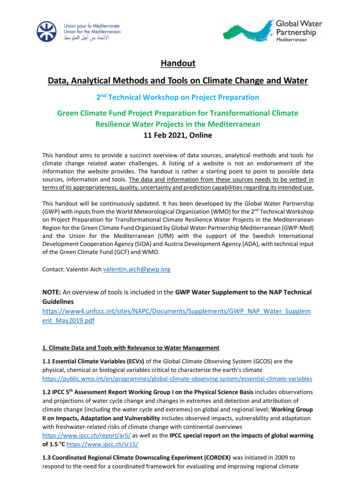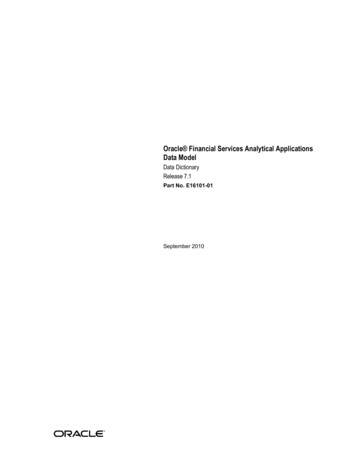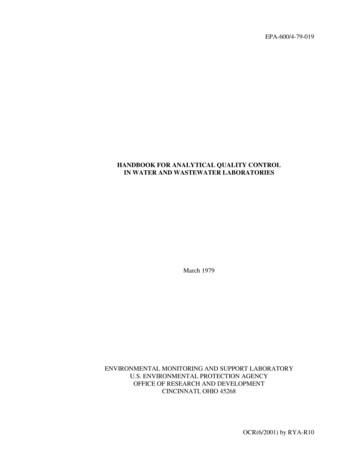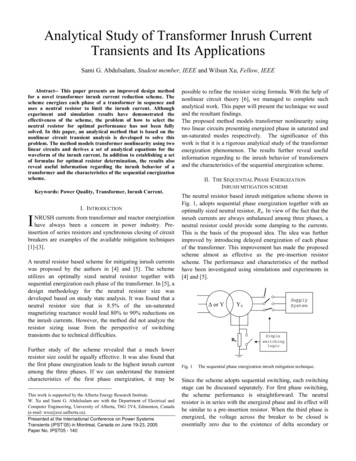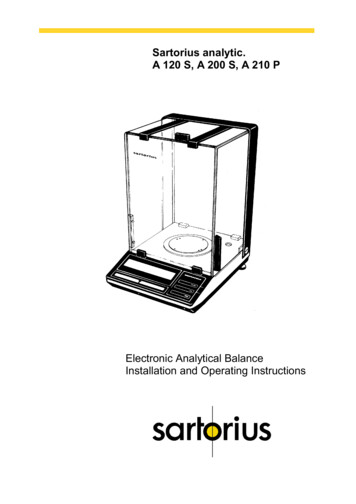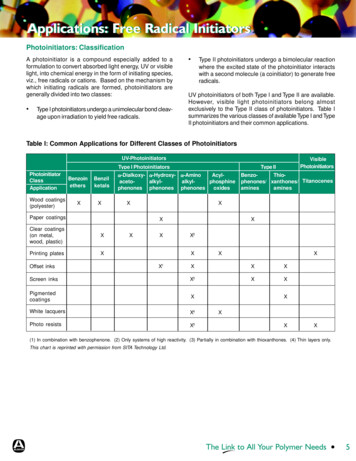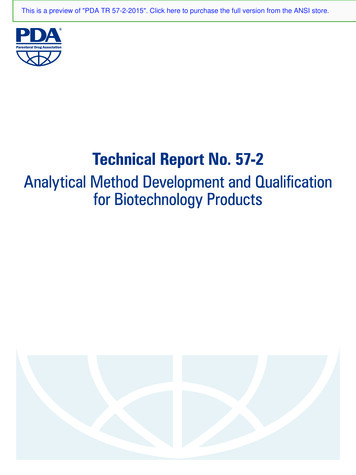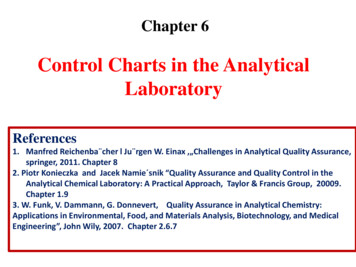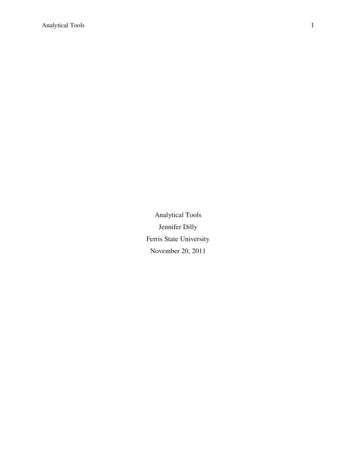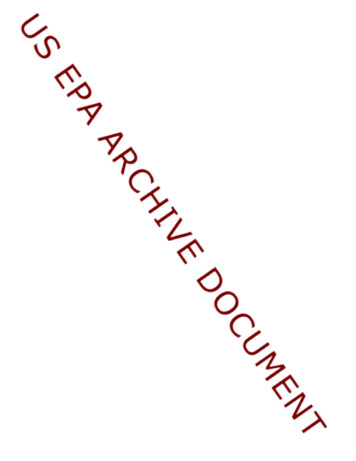
Transcription
Assessment of Analytical DataSubmitted by DuPontIn Response to Proposed Inorganic Chemical IndustryHazardous Waste Determination for K178This Document Does Not Contain Confidential Business InformationOctober, 2001U.S. Environmental Protection AgencyOffice of Solid WasteHazardous Waste Identification DivisionWaste Identification BranchAriel Rios Building1200 Pennsylvania Avenue, N.W.Washington, D.C. 20460
Table of Contents1.2.3.4.Introduction . . . . . . . . . . . . . . . . . . . . . . . . . . . . . . . . . . . . . . . . . . . . . . . . . . . . . . . . . . . . . 1Review Procedures . . . . . . . . . . . . . . . . . . . . . . . . . . . . . . . . . . . . . . . . . . . . . . . . . . . . . . . 2Review Products . . . . . . . . . . . . . . . . . . . . . . . . . . . . . . . . . . . . . . . . . . . . . . . . . . . . . . . . . 3Assessment . . . . . . . . . . . . . . . . . . . . . . . . . . . . . . . . . . . . . . . . . . . . . . . . . . . . . . . . . . . . . 44.1The Validity of DuPont’s Waste Analysis . . . . . . . . . . . . . . . . . . . . . . . . . . . . . . . . . 44.2Response to DuPont’s Comment (ICMP-00022-5a) . . . . . . . . . . . . . . . . . . . . . . . 114.2.1 Evaluation of DuPont’s Thallium Data for Iron RichTM . . . . . . . . . . . . . . . . . . . . . . . 114.2.2 Evaluation of DuPont’s Thallium Data for Wastewater Treatment Solids andWastewaters . . . . . . . . . . . . . . . . . . . . . . . . . . . . . . . . . . . . . . . . . . . . . . . . . . . . . 12List of TablesTable 4.1-1Table 4.2-1Table 4.2-2Table 4.2-3Table 4.2-4Table 4.2-5Table 4.2-6Rejected or Suspect Data Points . . . . . . . . . . . . . . . . . . . . . . . . . . . . . . . . . . . . . . 10Thallium in DuPont’s Iron RichTM (ICPMS- SW 6020) . . . . . . . . . . . . . . . . . . . . . 11Thallium in DuPont’s Iron RichTM (ICP- SW 6010) . . . . . . . . . . . . . . . . . . . . . . . . 12Thallium in DuPont’s Wastewater Treatment Solids (ICPMS- SW 6020) . . . . . . . . 12Thallium in DuPont’s Wastewaters (ICPMS- SW 6020) . . . . . . . . . . . . . . . . . . . . . 13Thallium in DuPont’s Wastewater Treatment Solids (ICP- SW 6010) . . . . . . . . . . . 13Thallium in DuPont’s Wastewaters (ICP- SW 6010) . . . . . . . . . . . . . . . . . . . . . . . 14List of AppendicesAppendix ADuPont’s Solids and Wastewaters Sampling and Analysis Strategies, Chloride-IlmeniteFacilitiesAppendix B CorrespondenceAppendix C Review Summary Reports and Updated Analytical Data Summary TablesAssessment of Analytical Data Submitted by DuPontIn Response to Proposed Inorganic Chemical IndustryHazardous Waste Determination for K178October 26, 2001
Assessment of Analytical Data Submitted by DuPontIn Response to Proposed Inorganic Chemical IndustryHazardous Waste Determination for K178October 26, 2001
1. IntroductionIn response to our K178 hazardous waste listing proposal (65 FR 55684, September 14,2000), E. I. Du Pont de Nemours and Company (DuPont) launched a significant sampling and analysiseffort to characterize the waste streams that we proposed for listing. DuPont collected 61 solidsamples from three chloride-ilmenite facilities to characterize those proposed to-be-listednonwastewaters (i.e., Iron RichTM (1 stream) and wastewater treatment sludges (6 streams)). Theyalso collected from those three facilities 44 wastewater samples to characterize wastewaters (11streams) that produce the wastewater treatment sludges of interest. The solid samples were analyzedby the Severn Trent Lab (STL) located in West Sacramento, California and the wastewater sampleswere analyzed by the STL in Denver, Colorado. All samples were analyzed using Inductively CoupledPlasma Mass Spectrometry (SW 6020- ICPMS) and/or Inductively Coupled Plasma-Atomic EmissionSpectrometry (SW 6010- ICP) for total and Synthetic Precipitation Leaching Procedure (SPLP)metals that included 21 metals; 2 streams were also assessed via Toxicity Characteristic LeachingProcedure (TCLP). Appendix A includes DuPont’s solid and wastewater sampling and analysisstrategies for the three chloride-ilmenite facilities. STL’s data packages were validated byEnvironmental Standards (ES) in Valley Forge, Philadelphia. DuPont’s analytical data and qualityassurance report (DuPont’s report) is available in the docket for today’s final rule.We proposed to list K178 as hazardous because our data showed that the waste containedelevated levels of manganese and thallium that would be mobile in the subsurface and might pose riskvia a groundwater ingestion scenario. DuPont submitted comments and data to support their positionthat thallium is not present in their wastes. DuPont also argued that their data show that the wastewatertreatment sludges do not contribute to the overall risks in the modeled waste. Our assessment ofDuPont’s data focused on the reported total and TCLP/SPLP concentrations of four constituents ofconcern (i.e., antimony, arsenic, manganese, and thallium) in Iron RichTM, wastewater treatment sludgesand wastewaters. The purpose of our assessment was to determine the validity of DuPont’s wasteanalysis so we could then evaluate their comments suggesting that thallium is not present in their wastes.See “Response to Comment Background Document”, ICMP-00022, Comment 5a-3 for DuPont’srelevant comments.Section 2 discusses the procedures we followed for this assessment. Section 3 describes theproducts we generated upon completion of our review of DuPont’s data. Section 4 assesses thevalidity of DuPont’s waste analysis and evaluates their comments.Assessment of Analytical Data Submitted by DuPontIn Response to Proposed Inorganic Chemical IndustryHazardous Waste Determination for K1781October 26, 2001
2. Review ProceduresWe conducted a complete review of DuPont’s report to determine the validity of their wasteanalysis. Various STL analytical operations were assessed, including waste sample shipments andhandling; sample preparation; waste TCLP and SPLP leachate extractions; waste sample/leachatedilutions; laboratory ICP and ICPMS instrument output; laboratory raw data calculations; and reportingof final analytical data points.DuPont’s original report has 11 volumes. DuPont submitted, as requested, additionalinformation and materials to facilitate our further review. DuPont’s supplemental information package,which includes STL’s original Contract Laboratory Program-like (CLP-like) electronic data package(in 9 CDs), is in the docket for today’s final rule. Appendix B includes our electronic mail to DuPontrequesting additional information and materials for our further assessment. DuPont’s report andsupplemental information package were reviewed by three chemists/senior data reviewers, Shen-yiYang, Environmental Protection Specialist of EPA, Office of Solid Waste, Hazardous WasteIdentification Division; Kelly Luck, Project QA Manager/Senior Data Validator of DynamacCorporation; Ray Anderson, QA Manager and Laboratory Coordinator of Science ApplicationsInternational Corporation.Assessment of Analytical Data Submitted by DuPontIn Response to Proposed Inorganic Chemical IndustryHazardous Waste Determination for K1782October 26, 2001
3. Review ProductsThe EPA data reviewers prepared QA/QC review summary reports documenting theirobservations and assessment of the quality of each of the ten data sets. The data reviewers alsoupdated DuPont’s analytical data summary tables1 to include (1) percent (%) moisture and pHs of thewaste samples (if measured), and final pHs of TCLP/SPLP waste leachates; (2) the ICP results for 4constituents of concern (i.e., antimony, arsenic, manganese, and thallium)2; (3) any revision to the ESapplied data qualifiers, including justifications for such revisions; and (4) the analytical results fromEPA’s sample, for easier comparison to DuPont’s results.Appendix C includes our review summary reports and updated analytical data summary tablesfor DuPont’s ten data sets. The ten data sets are:-Equalization Pond Sludge- Johnsonville Plant, New Johnsonville, TNSettling Pond Sludge- Johnsonville Plant, New Johnsonville, TNHillside Pond Sludge- Johnsonville Plant, New Johnsonville, TNEqualization Pond Sludge- DeLisle Plant, Pass Christian, MSDisengagement Basin Sludge- DeLisle Plant, Pass Christian, MSIron RichTM Filter Cake- Edge Moor Plant, Wilmington, DEWastewater Treatment Sludge- Edge Moor Plant, Wilmington, DEWastewater- Johnsonville Plant, New Johnsonville, TNWastewater- DeLisle Plant, Pass Christian, MSWastewater- Edge Moor Plant, Wilmington, DE1Originally submitted by DuPont in draft form in Attachment 5.1.3-B of their November 13,2001 comments (ICMP-00022) and in final form in their December 22, 2000 comments (ICMPL0003).2While DuPont did not report ICP results for antimony, arsenic, and thallium as part of theirformal comments, the analyses were automatically conducted when DuPont ran the ICP analyses formanganese and were submitted as part of DuPont’s raw data package. We also assessed these results.Assessment of Analytical Data Submitted by DuPontIn Response to Proposed Inorganic Chemical IndustryHazardous Waste Determination for K1783October 26, 2001
4. AssessmentSection 4.1 assesses the overall quality of DuPont’s waste analysis. Section 4.2 responds toDuPont’s comment pertaining to the presence of thallium in their wastes (ICMP-00022-5a-3).4.1The Validity of DuPont’s Waste AnalysisSTL performed waste analyses for a fast (two-week) turnaround time with a minimal (level I)QC check (by an analyst using a data review checklist) before delivery of the analytical data report toDuPont. ES performed a complete (100%) QA review following guidance from the “NationalFunctional Guidelines for Inorganic Data Review” (US EPA, 2/94). The areas ES reviewed included:sample holding times, sample condition upon lab receipt, instrument (ICP and ICPMS) tuning andcalibration, and field and laboratory QC sample results. ES made numerous hand-written additions(e.g., inorganic analyses support documentation, summaries for the laboratory’s analysis for initial andcontinuing calibration verification standards, initial and continuing calibration blanks, interference checksamples, serial dilutions, and PQLCRI standards) and changes (e.g., sample identification numbers,analysis date, method detection limits/reporting limits, dilution factors, and sample result calculations)throughout the entire report. The report was organized in a way that was difficult to follow and it hasmany data gaps that complicated our determination of whether those hand-written changes andcorrections were justifiable. Most hand-written changes and corrections were not initialed nor dated byES’ data reviewers. Therefore, we requested STL’s original CLP-like analytical data package tofacilitate our further review.In the course of our review, we found some major analytical problems with DuPont’s wasteanalysis:(1) STL’s method detection limit (MDL) studies are outdated. STL’s laboratory located inWest Sacramento, California, which analyzed the Iron RichTM and wastewater treatment sludgesamples, conducted their ICP and ICPMS MDLs and reporting limits (RLs) studies for metalsin early 19983. This is unacceptable since the operating conditions, time in service, andmaintenance affect the sensitivity of the instrument over time. A more appropriate time framewould have been on a quarterly basis 4. In addition, the ICPMS Method 6020A used for these3STL’s laboratory located in Denver, CO, which analyzed all the wastewater samples,conducted their ICP and ICPMS MDLs/RLs studies in early 2000.4Contract Laboratory Program (CLP) labs according to the CLP Inorganics Statement ofWork, ILMOS.OC, March 1999, require detection limit studies to be performed on a quarterly basisAssessment of Analytical Data Submitted by DuPontIn Response to Proposed Inorganic Chemical IndustryHazardous Waste Determination for K1784October 26, 2001
analyses requires detection limit studies to be determined at least every three months and keptwith the instrument log book5. We believe at a minimum the MDL studies should be performedon an annual basis. We were very surprised the STL-West Sacramento, California laboperated and responded to various external audits to establish applicable certifications withouta more current MDL study because such audits generally request and review for documentationto support the establishment of proposed detection and reporting limits and verify if thefrequency of MDL study updates is appropriate. STL's detection limits for ICPMS and ICPmetals should have been adjusted routinely for all associated sample analyses and matrices toreflect changes in target analyte responses over time using the most current MDL dataavailable. Since the MDL study data are outdated, the reported detection limits most likely donot reflect the current instrument operating conditions, sample preparations procedures, andpotential sensitivity changes. Therefore, all low-level concentrations (at or near the reportinglimit) and non-detect sample results associated with these outdated detection limits should beconsidered as estimated values and questionable validity.(2) STL appears not to have used the actual sample weight in their calculations for total ICPand ICPMS metals results. Because a method-recommended sample weight (not the actualsample weight) was used in their calculations, the ICP and ICPMS results for total metals in allsolid samples should only be considered to be accurate to no more than 2 significant figures.(3) The accuracy of DuPont’s “non-detect” and low-level positive results of several analytes inmany samples is questionable. Below are the problems we noticed in DuPont’s waste analysis.- The way STL’s ICPMS instruments were calibratedSTL’s ICPMS instruments were calibrated using a single-point calibration, not a calibrationcurve6. The ICPMS instruments (M01 and M02) used to assess Iron Rich and pond sludgesamples were calibrated using one standard (arsenic and manganese at 100 ug/l; antimony and
In addition, the ICPMS Method 6020A used for these (January, April, July, and October). 5 The SW-846 Chapter One guidance does not set a frequency at which MDLs should be updated, however, Section 4.4.1 of Chapter One does state that the laboratory should have procedures in place for demonstrating method proficiency and determining the MDL. Therefore, the laboratory should establish a written .
